Timber frame surveying
Scott Enders timber frame surveying in Cambidgeshire
Read about Scott’s journey through surveying a timber frame building for a home owner.

Timber frame repairs
The hidden damage
This case study is a good example of the damage that cement render can cause to historic timber framed buildings and why it is important to tread carefully when considering purchasing these types of buildings, especially when they the timber frame is not exposed and is covered with the wrong, impermeable materials.
The buyers of this house initially instructed us to carry out a Damp & Timber Survey of this timber framed. They had already had a full Building Survey by another surveyor who picked up a number of issues with dampness and was concerned about the condition of the timber frame.
When we arrived, we were presented with a house which had been extensively modernised with very little historic fabric left. The exterior walls were covered with a very thick cement roughcast render and the walls internally were solid plastered on the ground floor, and on the first floor lined with plasterboard. The timber frame was not visible at all. There was dampness in a number of the ground floor rooms.
The problems
Exposure of the timber frame revealed wood boring insect damage and very friable timber

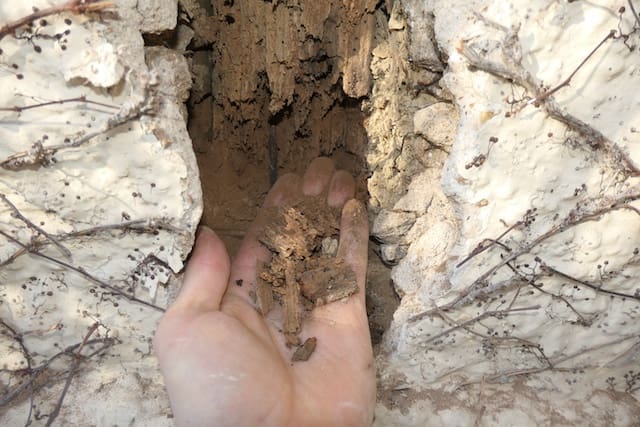
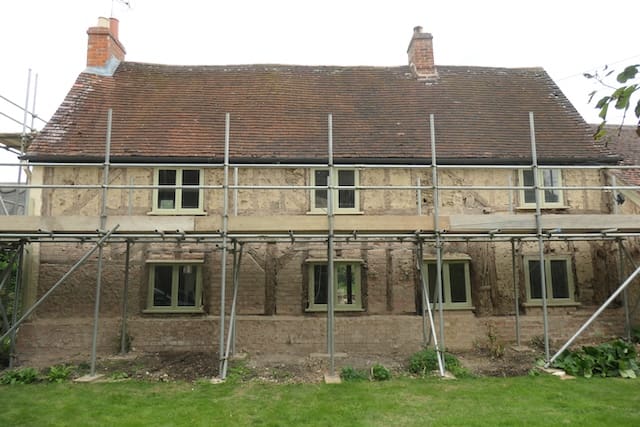
We obtained permission from the owner to remove the render in two locations to try and locate and check the condition of the timber frame. Small sections of render were removed, and we exposed small sections of vertical timber posts which had been extensively attacked and damaged by wood boring insects and which had a high moisture content. This was caused by decades and decades of moisture build-up behind the render which had caused the timber to become wet, subsequently resulting in insect attack.
Removal of the render in these areas also revealed that there were wattle and daub infill panels between the timber frame. The condition of these was difficult to assess as the areas of render removed were only very small. We suspected that many of these panels at ground floor level had been replaced with brick, given that the walls were solid when knocked.
Other factors which were resulting in dampness internally throughout the ground floor rooms were high external ground levels (these were level with the internal floors) and one of the rainwater downpipes at the front corner of the building simply discharged onto the ground and this was saturating the base of the walls. The presence of cement render meant that the walls were getting significantly damp but were not able to dry out.
We couldn’t remove any more render as our client did not yet own the house. We produced a report recommending that the render be fully stripped from the building so that the timber frame could be exposed and its condition assessed. As this is a Grade II listed building, this required listed building consent and planning permission.
The client bravely went ahead with the purchase of the house and later instructed us to submit listed building consent and planning permission applications. As we did not yet know the extent of the timber frame repairs needed, all we could do at this stage was to ask for consent for removing the render, repairing the timber frame and wattle and daub infill panels and re-rendering with a vapour permeable lime render.
We could not specify exactly what repairs were needed at this stage. We also proposed that any modern brick infill panels were removed and sheep wool insulation placed between the frame. Additionally, we proposed wood wool insulation boards to be screwed to the exterior of the frame and then the lime render would be applied over this.
We obtained listed building consent and planning permission for our client, however, the conservation officer at the Council required us to submit a timber frame condition survey and repairs schedule following the removal of the render and prior to any works commencing on the frame and infill panels.
The client arranged for the render to be removed which was very difficult as the render was 40mm thick! The client called us back out once the render had been removed to inspect condition of the timber frame and infill panels. The below photos show what was found following removal of the render.
The start of the repairs
Investigating the frame
It was what is clear that a large number of alterations were carried out in the 20th century. The brick plinth which the timber frame sits on has been rebuilt and the majority of the wattle and daub infill panels at ground floor level were replaced with brick. Additionally, areas of the timber frame had also been replaced with brick at ground floor level. Several wattle and daub panels remained at ground floor, but these were in very poor condition, as was the overall condition of timber frame which had been extensively attacked by wood boring insects and become very friable and lost a lot of its structural strength.
At first floor level much of the timber frame remained, with wattle and daub infill panel still present but in poor condition. The timber frame had been heavily altered. Various timbers were not connected to each other and there were areas where timbers were missing such as one of the corner posts and sections of the sole plates. The sole plate to the rear had completed rotted away.
Unfortunately, the contractor who removed the render damaged the first floor timbers with an angle grinder which resulted in horizontal cuts to the studs. This caused irreversible damage to the timbers.
The wattle and daub panels previously had a very thin coat of lime render on them but the vast majority of this fell off during render removal. There was only one small area to the rear where the lime render remained.
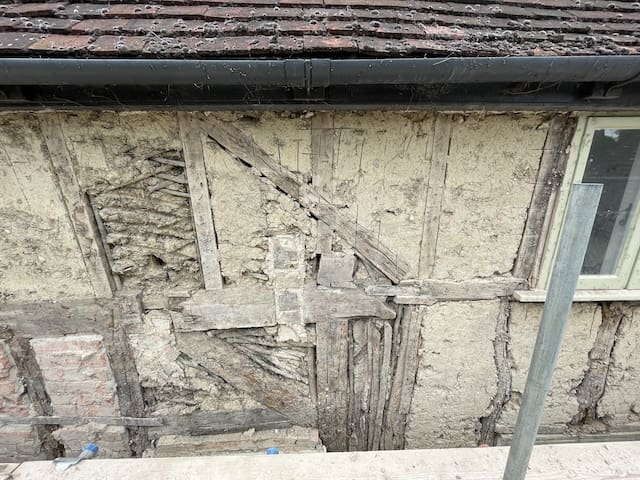
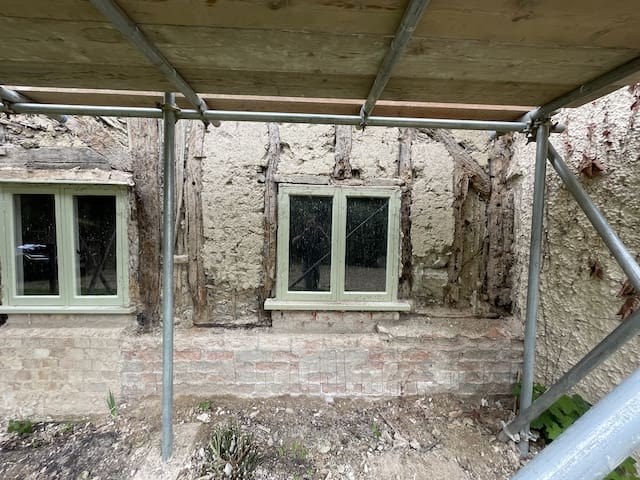
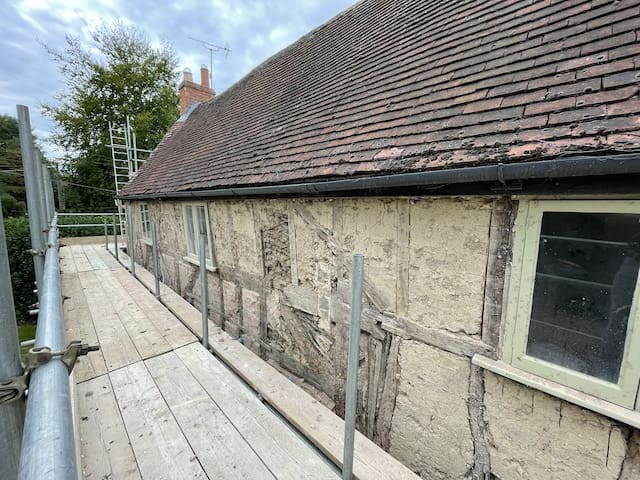
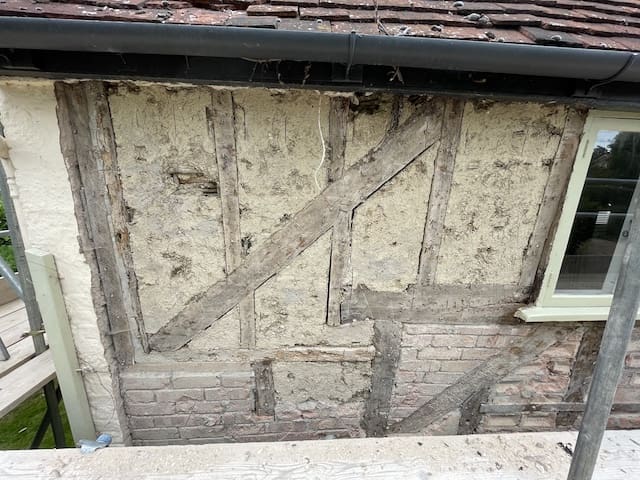
The repairs
Planning the repairs
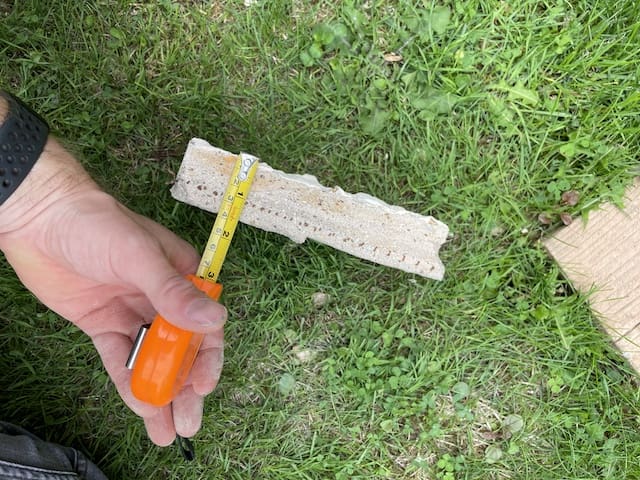
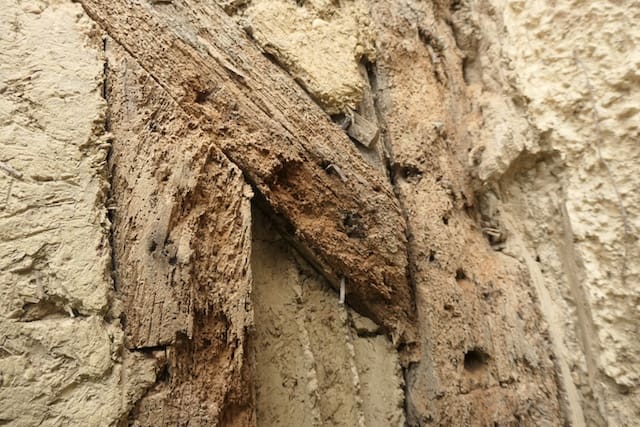
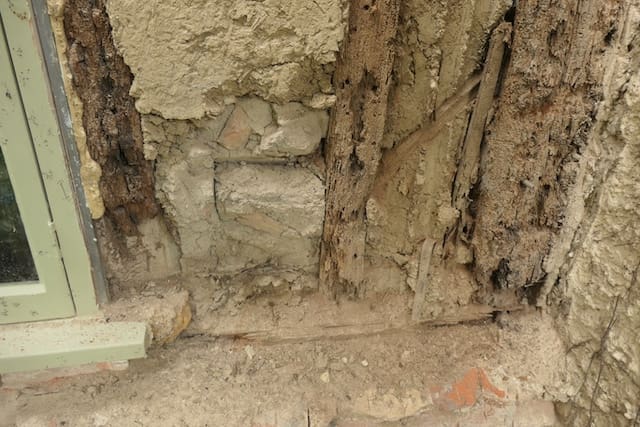
It was considered that the timber frame would have been exposed originally and never covered up. This was consistent with other timber frame houses in the village of a similar age. The client decided that he wanted to leave the frame exposed as opposed to re-rendering it. As listed building consent had only been obtained for re-rendering the frame we would need to submit another application for this. We invited the conservation officer back out to the property for a new pre-application meeting and asked his opinions on whether it would be acceptable to leave the timber frame exposed. Unfortunately, the conservation officer did not agree with this and required that the frame be rendered as it was previously, but thankfully we did not need to replicate the previous roughcast finish and was able to use a smooth finish.
We carried out a timber frame condition survey and repair schedule which proposed the following works:
- Removal of of all modern brick infill panels.
- Repair to wattle and daub infill panels.
- Repairs to timber frame and reinstatement of missing sections.
- Installation of sheep wool insulation between the frame where brick infill previously was.
- Installation of wood wool insulation boards over the frame.
- Application of lime render applied to wood wool boards and finished with limewash.
The report was submitted to the conservation officer who approved this, and the client was able to start the works which are currently ongoing.

